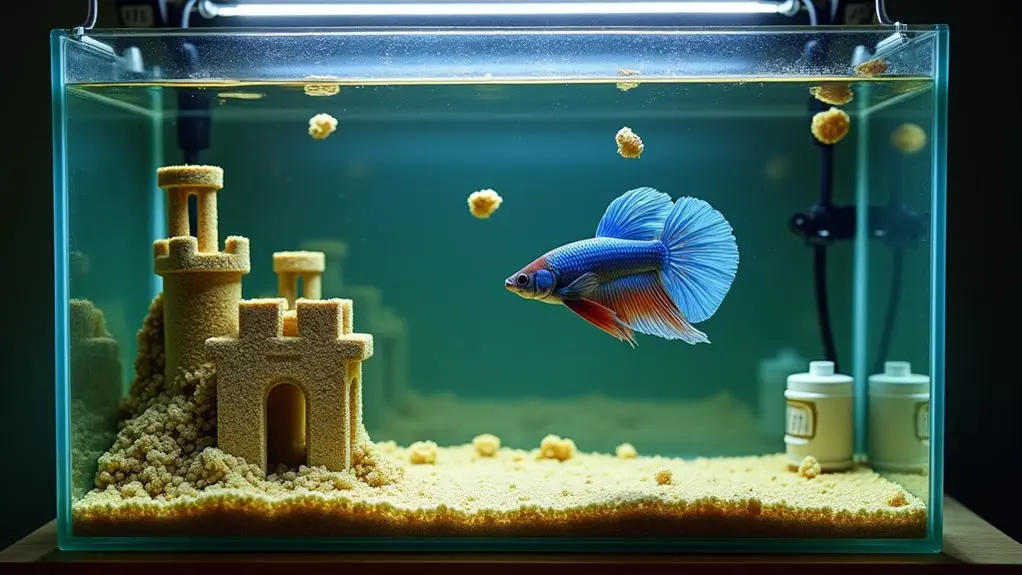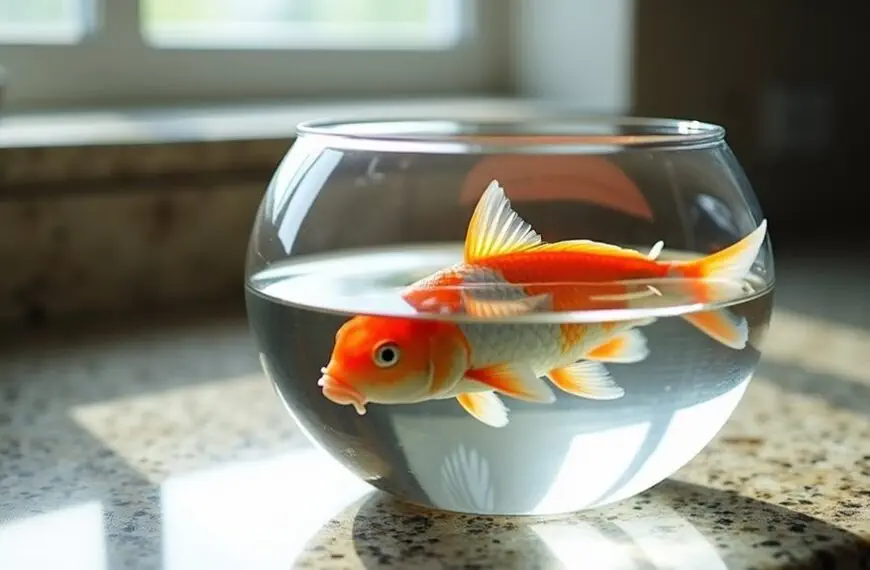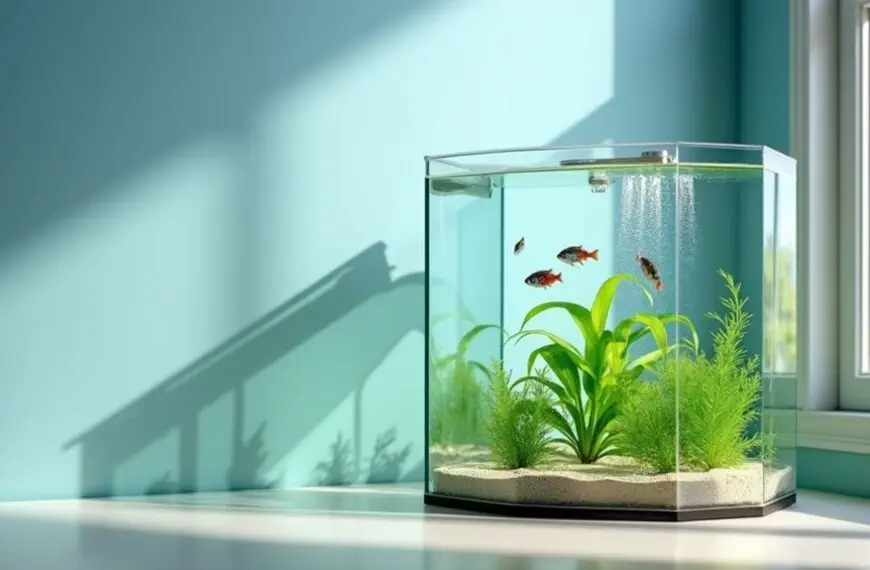Owning fish isn't as challenging as you might think, but it does require consistent care and attention to detail. You'll need to maintain proper water conditions, perform regular tank maintenance, and establish a feeding routine that takes about 15-20 minutes daily. While the initial setup costs $100-500, monthly expenses are manageable at $20-70 for food and supplies. The key to success lies in choosing compatible fish species, investing in quality equipment, and staying on top of water quality checks. Once you've got the basics down, you'll discover that fishkeeping is a rewarding hobby that brings both relaxation and joy. The more you understand about aquarium care, the easier it becomes to create a thriving underwater world.
Contents
- 1 Understanding Basic Fish Care
- 2 Tank Setup and Maintenance
- 3 Water Quality Management
- 4 Choosing the Right Fish
- 5 Daily and Weekly Tasks
- 6 Common Challenges for New Owners
- 7 Cost and Time Investment
- 8 Essential Equipment Needs
- 9 Fish Health and Disease Prevention
- 10 Long Term Care Requirements
- 11 Frequently Asked Questions
- 12 Final Thoughts
Understanding Basic Fish Care

A thriving aquarium begins with mastering the fundamentals of fish care. You'll need to maintain proper water conditions, as your finned friends rely on a clean, stable environment to show their natural fish behavior and brightest colors. Regular water changes of about 25% monthly help maintain optimal conditions for your fish. With 37,106 valid species of fish documented worldwide, there's a perfect match for every aquarium setup.
Think of it as creating their perfect underwater home – one where tank aesthetics meet essential care requirements.
You'll want to keep the water temperature between 74-82°F and maintain stable pH levels, just like you'd want your own living space to be comfortable.
When it comes to feeding, remember that less is more – your fish should finish their meal within five minutes, twice a day. It's like having dinner guests who know exactly when to stop eating!
Don't forget about compatibility – you wouldn't room with someone who keeps opposite hours, right? The same goes for your fish.
Research their needs and make sure tankmates get along swimmingly. Start with hardy species and gradually add more as you gain confidence.
Remember to quarantine new arrivals and handle them gently when needed – they'll thank you by displaying their most vibrant personalities in your carefully crafted underwater world.
Tank Setup and Maintenance
Your journey to successful fish-keeping starts with gathering essential equipment, including a properly-sized tank, reliable filter, and accurate thermometer.
You'll need to master water quality management through regular testing and conditioning, ensuring your aquatic friends have a clean, healthy environment to thrive. Maintaining consistent temperatures between 22-27°C is vital for tropical fish health and well-being. It's crucial to establish proper cycling of your tank before adding fish to create a stable nitrogen cycle. Additionally, maintaining a stable pH level is essential for the health of beneficial bacteria in your tank.
Setting up a consistent cleaning schedule that includes weekly water changes and monthly deep-cleans will help you maintain a beautiful, thriving aquarium that's a joy to watch.
Initial Equipment Requirements
Setting up a fish tank requires careful planning and essential equipment to create a healthy aquatic environment. When you're gathering your aquarium accessories, you'll need several key items to get started. A reliable filtration system, heater, and thermometer are must-haves to maintain proper water conditions for your finned friends. For safety reasons, make sure all electrical equipment is connected to ground fault interrupters.
Don't forget to pick up a good substrate – about a pound of gravel per gallon of water will do the trick! Regular cleaning of the gravel using an aquarium vacuum is essential for maintaining water quality, as proper filtration systems also play a crucial role in keeping the water clean and clear.
Your fish tank setup isn't complete without proper lighting, which you'll want to run for up to eight hours daily (your fish aren't huge fans of all-night parties). You'll also need some practical tools like a fishnet, siphon, and bucket for regular maintenance – think of them as your aquarium cleaning crew!
If you're wondering about tank size, a 20-gallon tank is a great starting point, but remember that bigger is usually better when it comes to creating a stable environment.
Position your tank on a sturdy aquarium stand – after all, water's heavy stuff at 10 pounds per gallon! Just keep it away from windows and air vents to avoid any unwanted temperature swings, as maintaining a consistent environment helps prevent stress for your fish.
#
Water Quality Management
Managing water quality stands as the cornerstone of successful fish keeping. You'll need to master a few key parameters to keep your finned friends healthy and happy. Regular water quality testing guarantees you're maintaining the right environment, with pH levels between 6.5 and 8.2 being essential for fish survival. Live aquatic plants can significantly improve water quality by absorbing excess nutrients and providing natural filtration. Moreover, maintaining optimal nitrate levels (below 40 ppm) is crucial to prevent long-term health issues in fish.
Setting up your tank correctly from the start will save you countless headaches later. You'll want to position your tank away from windows and air vents, thoroughly rinse all equipment, and let your tank cycle properly before adding any fish. Most tropical fish require water temperatures between 24-30°C for optimal health.
Think of it as preparing a new home – you wouldn't move in while the paint's still wet, right?
When it comes to maintenance, you're looking at weekly water changes and regular filter cleaning to keep things running smoothly. pH adjustment might sound intimidating, but it's really just about making small, careful changes when needed, especially if you notice any unfavorable test parameters.
Cleaning Schedule Basics
A well-planned cleaning schedule builds on proper water quality management and forms the foundation of a thriving aquarium.
You'll need to establish daily, weekly, and monthly cleaning techniques to keep your fish happy and healthy in their underwater home.
Your daily routine should include checking that filters and pumps are working properly, removing uneaten food (those little gluttons don't always finish their meals!), and topping off water levels. Fish should display excited eating behavior during feeding times, as this indicates good health, and maintaining a stable environment is vital for their well-being. Maintaining a water temperature range between 75-80°F is essential for most freshwater fish.
Weekly tasks focus on testing water parameters and algae management – you'll become quite the expert with that algae scraper!
Every two weeks, you'll want to perform a 25% water change and vacuum the gravel to remove debris.
For monthly deep cleaning, you'll need to be more thorough.
Start by unplugging equipment and removing some water. Then, give your decorations a gentle rinse with hot water (no soap, please – your fish won't appreciate that bubble bath!).
Clean the gravel bed thoroughly and scrub those tank walls to ensure a healthy environment without harmful contaminants.
## Water Quality Management

Maintaining proper water quality stands as the cornerstone of successful fish keeping. You'll need to monitor several parameters regularly through water testing and implement effective filtration techniques to keep your aquatic friends healthy and happy.
Think of yourself as a water quality detective, constantly on the lookout for signs that something's not quite right.
Here's what you'll need to check regularly to guarantee your fish thrive:
- Test pH levels weekly – it's like checking your fish's comfort zone
- Monitor ammonia and nitrate levels – these are the silent troublemakers
- Keep an eye on water temperature – fish are particular about their "swimming weather"
- Check TDS levels monthly – think of it as your water's "cleanliness score"
Don't worry if this sounds overwhelming at first – you'll get the hang of it! Testing your water parameters regularly fosters a balanced ecosystem, essential for fish health.
Regular water changes (about 15-20% weekly) are your best friend in maintaining good water quality.
Remember to clean your gravel without going overboard – those beneficial bacteria are your allies in keeping the tank's ecosystem balanced.
If you notice your fish acting strange, it's usually your first clue that the water needs attention.
Choosing the Right Fish
Choosing the right fish stands out as one of the most essential decisions in your aquarium journey. You'll need to take into account several factors to guarantee your finned friends will thrive in their new home, and it all starts with proper species research.
Think of it like finding the perfect roommate – you wouldn't want to pair a party animal with someone who needs complete silence!
When it comes to fish compatibility, you'll want to examine each species' temperament carefully. If you're mixing different types, make sure they're all peaceful creatures who'll get along swimmingly – literally!
Look for healthy specimens with bright eyes, undamaged fins, and active behavior. You don't want to bring home a fish that's under the weather!
Before you make your final selection, reflect on your tank's size and capabilities. Each inch of fish typically needs 1-2 gallons of water, so you can't expect a tiny tank to house that gorgeous foot-long angelfish you've been eyeing. Maintaining stable water conditions is crucial for your fish's well-being.
Start small with a few hardy species, and as you gain confidence, you can gradually add more fish to your underwater community.
Daily and Weekly Tasks
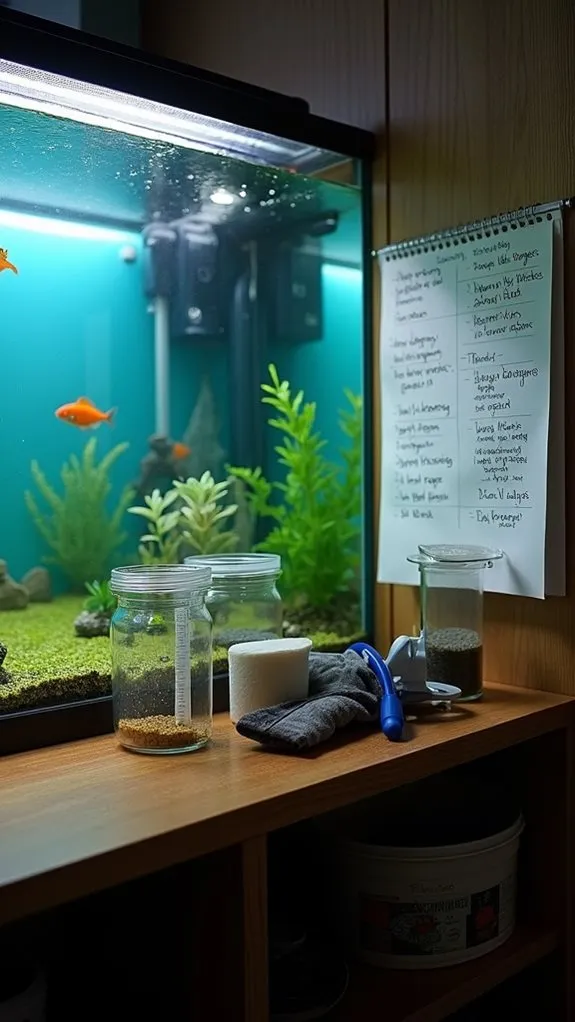
For successful fish keeping, your daily and weekly maintenance routines will make all the difference between a thriving aquarium and a troubled one.
Think of yourself as a fish's personal caretaker – they're counting on you to keep their home clean and comfortable!
Your daily tasks center around fish feeding and equipment checks. You'll want to observe your finned friends during meal times, as this helps you spot any unusual behavior early on.
It's also the perfect opportunity to guarantee your equipment is running smoothly.
Here's what your weekly schedule should look like:
- Change 10-25% of the water to keep it fresh and clean
- Remove any algae buildup from the tank walls and decorations
- Vacuum the gravel to eliminate waste and debris
- Count your fish to make sure everyone's present and accounted for
To optimize your aquarium, consider incorporating beneficial bacteria to help maintain consistent water quality.
Don't worry – these tasks aren't as time-consuming as they might sound.
Once you get into a routine, you'll find that maintaining your aquarium becomes second nature.
Plus, there's something oddly satisfying about watching your fish explore their freshly cleaned home!
Common Challenges for New Owners
New fish owners face several common pitfalls that can make or break their aquarium experience.
It's like jumping into the deep end without learning to swim first – you'll likely struggle if you don't take time to understand the basics of fish care and tank maintenance.
One of the biggest challenges you'll encounter is maintaining proper water quality.
You might be tempted to overfeed your fish because they're so cute when they beg for food, but this can quickly lead to water problems and affect fish behavior.
It's also essential to understand how biological filtration works and why you can't just add all your fish at once to a new tank.
Learning to spot common diseases and understanding the nitrogen cycle will save you headaches down the road.
You'll need to resist the urge to clean everything too thoroughly – those beneficial bacteria are your friends!
Remember to test your water regularly and perform consistent water changes. Regular monitoring of water quality parameters is crucial to keep your fish healthy and thriving.
While it might seem overwhelming at first, taking time to research and prepare before getting your first fish will help you avoid these common challenges and create a thriving underwater world.
Cost and Time Investment
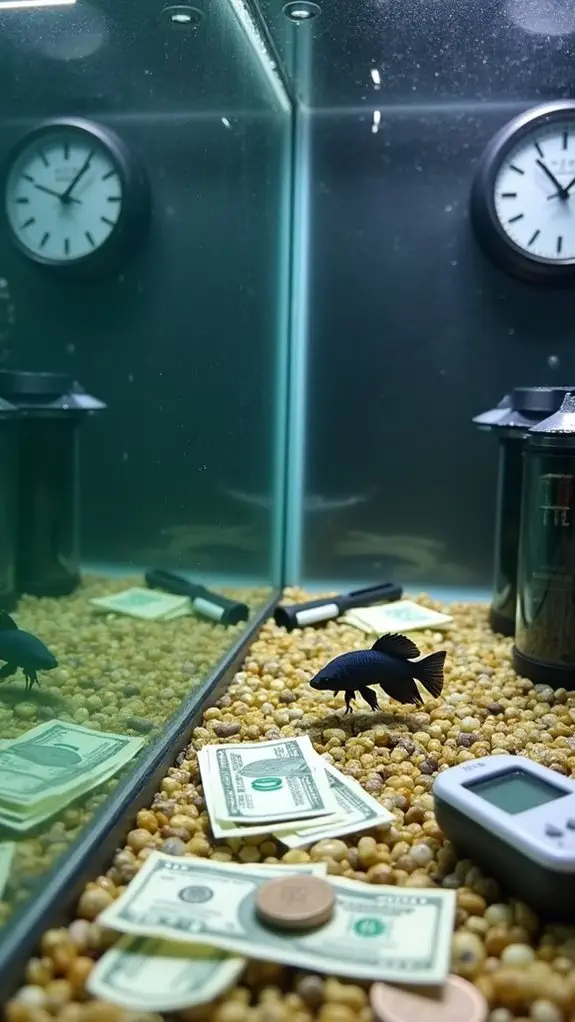
Beyond mastering fish care basics, aspiring aquarium owners must understand the financial and time commitments involved. The cost breakdown can be eye-opening, as you'll need to budget for both initial setup and ongoing expenses. While you might think fish are a low-maintenance pet, they actually require consistent attention and care to thrive.
Let's break down what you're looking at regarding investments:
- Initial setup: $100-500+ for your basic tank setup, including equipment like filters, heaters, and lighting.
- Monthly expenses: $20-70 for food, utilities, and routine maintenance supplies.
- Yearly maintenance: $300-500 for replacements and necessary chemicals.
- Emergency fund: $50-100 for unexpected health issues.
The time commitment isn't just about dropping food in the tank once a day. You'll need to dedicate time for daily monitoring, regular water testing, and tank maintenance. Additionally, understanding water quality management is crucial for ensuring your fish remain healthy and vibrant.
Think of it like having an underwater garden – it needs consistent care to flourish. While it's not overwhelming, you should plan to spend at least 15-20 minutes daily on basic care, plus a few hours monthly for deeper cleaning and maintenance.
Essential Equipment Needs
You'll need some key pieces of equipment to give your fish a healthy home, starting with a properly sized tank and a reliable filter system.
Your filter is like your aquarium's kidney, keeping the water clean and healthy for your finned friends, and you'll want to choose one that's rated for your tank size. It's important to consider that your filter should be capable of filtering double the tank volume/hour to ensure optimal cleanliness.
While there are many filter types to pick from – including hang-on-back, canister, and sponge filters – each has its own benefits, and we'll help you figure out which one's right for your setup.
Basic Equipment Must-Haves
Setting up a successful aquarium requires several essential pieces of equipment that form the foundation of your fish-keeping journey.
When it comes to tank types and essential supplies, you'll need to make some significant decisions right from the start. Your aquarium's size matters – remember that bigger tanks actually provide more stable conditions for your fish, though you'll need to take into account your available space.
Here's what you'll absolutely need to get started:
- A properly-sized tank with a sturdy stand (remember that water weighs about 10 pounds per gallon!)
- A reliable filtration system and heater to maintain water quality and temperature
- Appropriate lighting to support both fish and plant life
- Basic maintenance tools like a siphon, nets, and dedicated cleaning supplies
You'll want to invest in quality equipment rather than cutting corners – trust me, it'll save you headaches down the road.
While you might be tempted to skip certain items, each piece plays a vital role in creating a healthy environment for your underwater friends.
Think of your aquarium as a tiny ecosystem where every component works together to keep your fish happy and thriving.
Choosing Your Filter System
When it comes to maintaining a healthy aquarium, choosing the right filter system stands as one of your most essential decisions.
You'll need to take into account your tank size, fish type, and how much time you can dedicate to filter maintenance to make the best choice.
For smaller tanks or breeding setups, you might want to start with a simple sponge filter or internal filter.
They're easy to maintain and provide excellent biological filtration, though you'll need to clean them regularly to maintain filter efficiency.
If you've got a medium-sized tank, a hang-on-back filter could be your best friend – they're versatile, effective, and won't break the bank.
For larger aquariums, you'll want to think about a canister filter.
While they're a bit more complex and require more maintenance, they're powerhouses when it comes to keeping your water crystal clear.
Just remember, whatever filter you choose, it needs to handle all three types of filtration: biological, mechanical, and chemical.
Think of it as your tank's life support system – it's not just about keeping the water clear, it's about creating a healthy home for your finned friends.
Fish Health and Disease Prevention

Keeping up with your fish's health is one of the most critical aspects of aquarium ownership. You'll need to regularly monitor your fish's behavior and watch for any unusual signs that might indicate disease symptoms. Think of yourself as a fish detective – the earlier you spot a problem, the better chance you have of treating it successfully.
To maintain healthy fish, you'll want to follow these essential steps:
- Check water quality daily – it's like ensuring your fish have clean air to breathe.
- Monitor feeding patterns – a fish that's not eating might be telling you something's wrong.
- Keep the tank clean through regular maintenance – just like you wouldn't want to live in a dirty house.
- Quarantine new fish before adding them to your main tank – it's better to be safe than sorry!
Prevention is always easier than treatment, so you'll want to stay on top of tank maintenance. If you notice anything unusual, like white spots, frayed fins, or unusual swimming patterns, don't wait to take action.
Long Term Care Requirements
In addition to daily care, successful fish keeping requires a long-term commitment to maintaining your aquarium's ecosystem.
You'll need to establish a regular routine that includes weekly water changes, monthly filter maintenance, and consistent water quality testing. Think of it as creating a spa-like environment where your finned friends can thrive!
When it comes to fish nutrition, you'll want to research the dietary needs of your specific species and provide a balanced diet that keeps them healthy and active.
Remember to clean the tank regularly, replacing about 25% of the water weekly while using an aquarium vacuum to remove debris from the gravel.
Tank aesthetics aren't just about making your aquarium look pretty – they play a vital role in your fish's well-being. You'll want to maintain proper decoration coverage and swap items periodically to keep the environment stimulating.
Don't forget to plan for equipment maintenance and replacement.
Keep spare filters, pumps, and other essential supplies on hand, and consider setting up a quarantine tank for new additions to your underwater family.
Your fish will thank you with years of entertaining companionship!
Frequently Asked Questions
Can Fish Recognize Their Owners and Show Affection?
Yes, your fish can recognize you through sight and sound. They'll show affection through distinctive fish behavior like swimming closer when you approach, especially during owner interaction and feeding times.
Do Fish Need Darkness at Night to Sleep Properly?
While your fish don't need complete darkness, they do benefit from nighttime lighting changes. You'll want to maintain regular light/dark cycles to support healthy fish sleep patterns and reduce stress in your aquatic pets.
Is It Normal for Fish to Change Colors Occasionally?
Yes, it's perfectly normal for your fish to change colors occasionally. These changes can be natural responses to aging, breeding seasons, or their environment. However, sudden color changes might indicate fish stress.
How Do Fish Communicate With Each Other in the Tank?
You'll notice your fish communicate through body language like fin displays and postures. They'll also use sound signals by vibrating their swim bladders, and release chemical signals to share information with tankmates.
Can Fish Get Lonely if Kept Alone in the Tank?
No, your fish won't get lonely in the traditional sense. While some species enjoy tank mates for companionship, most fish don't experience loneliness like humans do. They're content as long as their environment's well-maintained.
Final Thoughts
While owning fish isn't the most difficult pet choice you'll ever make, it does require your consistent attention and care. You'll need to stay on top of water quality, maintain proper equipment, and develop a regular cleaning routine. But once you've got the basics down, you'll find that fishkeeping can be an incredibly rewarding hobby. With proper planning and dedication, you're well-equipped to create a thriving aquatic environment for your finned friends.

